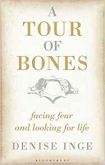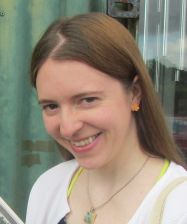A Tour of Bones: Facing Fear and Looking for Life by Denise Inge
| A Tour of Bones: Facing Fear and Looking for Life by Denise Inge | |
|
| |
| Category: Autobiography | |
| Reviewer: Rebecca Foster | |
| Summary: Facing a basement full of bones and later a diagnosis of inoperable sarcoma, Inge toured some of Europe's notable charnel houses, pondering what remains of us after life and how to approach death with humility and awe. A splendid memento mori. | |
| Buy? Yes | Borrow? Yes |
| Pages: 224 | Date: November 2014 |
| Publisher: Bloomsbury | |
| ISBN: 9781472913074 | |
|
| |
American-born Dr Denise Inge was an expert on seventeenth-century mystic poet Thomas Traherne, mother to two daughters, and wife to an Anglican clergyman. Her husband's appointment as Bishop of Worcester saw them move to a townhouse adjacent to Worcester Cathedral – and attached to a charnel house. Whatever to do with a basement full of bones? An even more pressing question was what to do with her fear of the death they represented, especially when Inge was diagnosed with inoperable sarcoma late in the writing process.
For Inge, the answer was to engage her anxiety head-on, first by exploring her basement crypt and then by travelling with her friend Zuzana to four of Europe's most notable charnel houses. 'From this belly of our house I began a kind of quest into fear so that I might overcome it…This opened door in my house, between the humdrum everyday and heaped mortality, never stopped asking questions.' The two women journeyed to the eighteenth-century Skull Chapel of Czermna, Poland, stuffed with skeletons and adorned skull cups, and on to Sedlec, Czech Republic, where Cistercian monks constructed a death palace complete with bone towers and chandelier.
Sedlec grew up around a medieval legend: the founder brought back soil from the Holy Land, guaranteeing anyone buried there heaven within three days. Yet now its caretaker thinks it should be closed; the dead should lie in peace, not be part of a tourist spectacle, he says. Inge takes this opportunity to ponder the doctrine of bodily resurrection. Most Christians believe in resurrection, but the details vary. Do we need our bones to regenerate in a physical form, or should resurrection be understood metaphorically? As a bishop’s wife, Inge is well placed to discuss the issues; this is one of the most fascinating sections of the book.
Next Inge and Zuzana (who translated) journeyed to Hallstat, Austria, a salt mine until the mid-1800s. Here they met the last skull painter, August Stögner. There are four traditional wreath designs for skulls – ivy, laurel, oak or rose – each with symbolic meaning. Paired with the name of the deceased, this makes for tremendous intimacy. 'This is a meeting point with mortality,' Stögner says. 'This is a confrontation. For some it is positive, for some negative. Some visitors shout and storm out of the ossuary.'
Yet Inge was starting to see things differently, to move beyond the knee-jerk horror. 'My newest neighbours are going to be bones; and I have been invited to embrace the bones within, to 'count my days', as the Psalmist says, because looking at mortality can make you wise.' Their last stop: Naters in the Swiss Alps. Mountains symbolise 'the sublime', a classical mixture of beauty and terror. Yet the motto on the bone wall there expresses a truth some are reluctant to accept: 'What you are, we were / What we are, you shall be.'
And this, really, is what Inge's tour is about: accepting one's place in a continuum of humanity, once living or now alive, but eventually all joined in death. Much more than a charnel house tour, it far surpasses a travel book like Alexia Brue's Cathedrals of the Flesh, her trip around Europe and Asia's bath houses. Inge expertly weaves so many topics into her lyrical prose: funeral customs; the modern denial of death (including euphemistic language), especially in America; the difficulty of maintaining humility; and the theological questions and answers she unearthed among the bones. Have you found a lasting hope? Sedlec seemed to ask. She replies, 'Anchor yourself in the eternal and abiding (for me this is God).'
Autobiographical information is fairly sparse, but always serves to illuminate and ground the big ideas discussed. Inge felt a lifelong sense of rootlessness. Her family, from Pennsylvania Mennonite stock, moved to the American South; then three of five siblings moved abroad. Inge loved the English life she'd fallen into, but longed for a home you can feel in your bones; instead she knew the 'deep displacement of adaptation.' On the day her father died of liver cancer, her adoption of a baby boy fell through: she knew loss at a life's start as well as at its end. I'm an American expat, too, and with my 96-year-old grandmother on her deathbed in Georgia and my brother-in-law nearing the inevitable end of a battle with brain cancer, this book meant so much to me personally. I cannot imagine anyone for whom it will not resonate.
Fear turns to reverence when we realise that death is our common destination and causes all divisions between people to melt away. Inge died of cancer, aged 51, at Easter 2014. This splendid posthumous book – a true memento mori but, more importantly, a timeless celebration of human vitality and collective memory – will long outlast her too-short life. Essential reading.
Further reading suggestion: Ammonites and Leaping Fish: A Life in Time by Penelope Lively ponders old age and memory, whilst Nothing to be Frightened of by Julian Barnes more specifically addresses the fear of death. For a much lighter book set partially in a crypt, try Speaking from Among the Bones by Alan Bradley. The Sedlec ossuary also inspired some scenes of The Alchemist and the Angel by Joanne Owen.
Please share on: ![]() Facebook,
Facebook, ![]() Twitter and
Twitter and
![]() Instagram
Instagram
![]() You can read more book reviews or buy A Tour of Bones: Facing Fear and Looking for Life by Denise Inge at Amazon.co.uk Amazon currently charges £2.99 for standard delivery for orders under £20, over which delivery is free.
You can read more book reviews or buy A Tour of Bones: Facing Fear and Looking for Life by Denise Inge at Amazon.co.uk Amazon currently charges £2.99 for standard delivery for orders under £20, over which delivery is free.
![]() You could get a free audio download of A Tour of Bones: Facing Fear and Looking for Life by Denise Inge with a 30-day Audible free trial at Amazon.co.uk.
You could get a free audio download of A Tour of Bones: Facing Fear and Looking for Life by Denise Inge with a 30-day Audible free trial at Amazon.co.uk.
![]() You can read more book reviews or buy A Tour of Bones: Facing Fear and Looking for Life by Denise Inge at Amazon.com.
You can read more book reviews or buy A Tour of Bones: Facing Fear and Looking for Life by Denise Inge at Amazon.com.
 A Tour of Bones: Facing Fear and Looking for Life by Denise Inge is in the Top Ten Autobiographies 2014.
A Tour of Bones: Facing Fear and Looking for Life by Denise Inge is in the Top Ten Autobiographies 2014.
Comments
Like to comment on this review?
Just send us an email and we'll put the best up on the site.


